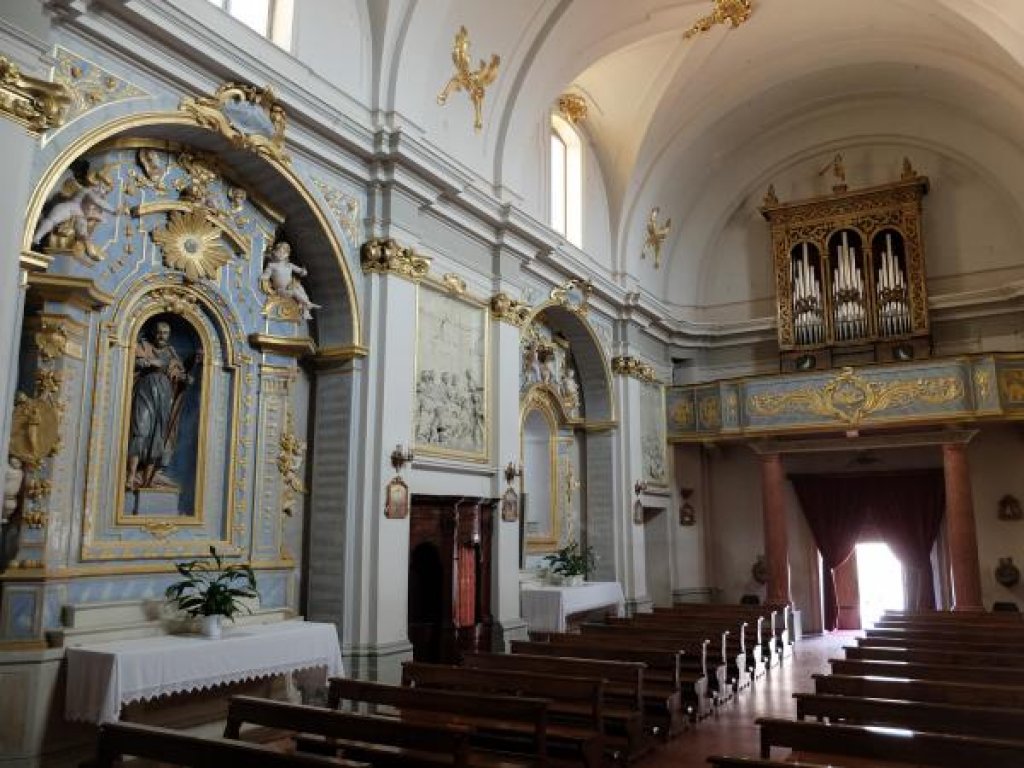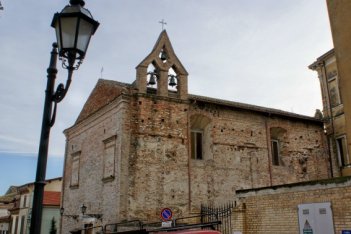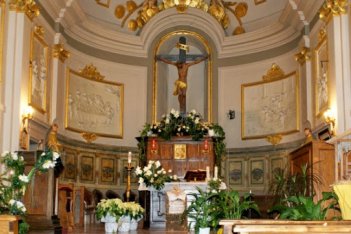- Home
- Punti di interesse
- Contrada di San Francesco: la chiesa di Sant'Antonio da Padova e il Torrione
Descrizione
In origine dedicata a San Francesco, era parte di un grande convento francescano costruito lungo le mura meridionali nel corso del Cinquecento. Dopo aver ospitato il carcere e il Municipio nell’Ottocento, il convento fu smantellato per lasciare il posto all’edificio scolastico nel 1912. La facciata in laterizio mostra le varie fasi di costruzione: nella muratura si distingue il tetto a capanna con una finestra centrale della prima chiesa e la sopraelevazione sei-settecentesca. Tra i più ricchi della regione, il centro conventuale venne progressivamente distrutto all’inizio del Novecento per lasciare posto all’edificio scolastico tuttora esistente. Il portale d’ingresso in pietra reca la scritta in capitali latine STIGMATA CRISTI SUSTULIT ECCE DOMUS 1566: “le stigmate di Cristo sostengono questa dimora 1566”.
L’interno, con le sue sculture e i suoi rilievi in stucco, è un sorprendente trionfo del tardo-barocco: tra i principali monumenti del Settecento in Abruzzo, è opera delle maestranze guidate da Girolamo Rizza da Veglio. Sulle pareti movimentate da nicchie con altari, corrono dei riquadri con scene a rilievo del Vecchio e Nuovo Testamento. L’abside è dominata dal gruppo di rilievi in stucco della Gloria di San Francesco. Sopra la cantoria all'ingresso spicca la cassa d’organo realizzata da Onofrio Cacciapuoti e dalla sua bottega nel 1737.
Lungo via del Popolo troviamo il torrione "Il Bianco", detto anche di Porta Napoli. Dopo i lavori ottocenteschi per il riempimento del fossato la torre è rimasta per buona parte interrata e al momento è visibile soltanto la cima del baluardo. Sulla muratura è possibile notare le aperure per la difesa.
La Contrada di San Francesco è compresa nella parte merdionale della città di Giulia, un tempo a ridosso delle mura a Sud. La Contrada è formata da piccole stradine chiamate "ruette". Una delle più caratteristiche è certamente il Vico del Gallo, una traversa di via San Francesco, a pochi passi dalla chiesa di Sant'Antonio: un luogo dove riposare all'ombra dei tigli gustando il silenzio e la vita degli abitanti.
----ENG----
Originally dedicated to St Francis, it was part of a large Franciscan monastery built along the southern walls in the 16th century. After housing the prison and town hall in the 19th century, the monastery was closed in 1912 in favor of the school building. The brick facade shows the different construction phases: the gabled roof with central window of the first church protrudes from the masonry and the elevation from the 17th - 18th century. One of the richest monastic centers in the region was gradually destroyed at the beginning of the 20th century to make way for the school building that still stands. The stone entrance portal bears the inscription in latin capital letters STIGMATA CRISTI SUTULIT ECCE DOMUS 1566: "The stigmata of Christ protect this house in 1566".
The interior, with its sculptures and stucco reliefs, is a surprising impression of the late Baroque: among the most important monuments of the 18th century in Abruzzo, it is the work of Girolamo Rizza da Veglio's pupils. On the walls with niches and altars, there are paintings with relief scenes from the Old and New Testaments. The apse is dominated by a group of stucco reliefs depicting the glory of San Francesco. Above the choir loft at the entrance stands out the organ made in 1737 by Onofrio Cacciapuoti in his workshop.
Along Via del Popolo we find the tower “Il Bianco”, also known as Porta Napoli. After the nineteenth century works to fill in the moat, the tower was mostly covered and at the moment only the top of the tower is visible. The openings for defense can be seen on the top of the tower.
The district of San Francesco is located in the southern part of the city of Giulia, once close to the city walls. The district consists of small alleys called "Ruette". One of the most characteristic is certainly the "Vico del Gallo", a side street of Via San Francesco, a few steps from the Church of “Sant'Antonio”: a place to rest in the shade under the linden trees and enjoy the silence and the life of the residents.



